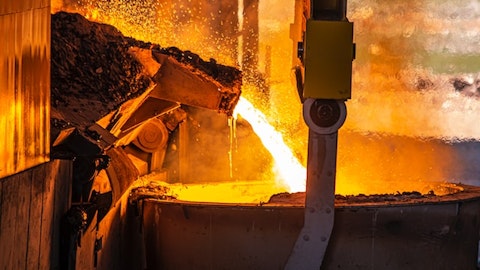David Wright: So this is the list of stuff that you had finished and now, as you’re shipping it, is how it’s hitting the P&L, and you’ve got more of that to ship this year, correct?
David Anderson: Yes, sir. That’s correct. That’ll be over this year.
David Wright: Your backlog in your segment was down around $11 million from Q3 to Q4. You booked a lot of good business last year, I know. What’s the booking environment been here in the first quarter for your business?
David Anderson: For Buffalo Pumps and for Aerofin, it’s been really good, solid bookings. For Buffalo Air, lower just because we have booked so much that we’re pretty far out now as far as using our capacity. Even with the expansion that we did last year, we’ve been able to sell that capacity quickly.
David Wright: Okay, well, that’s encouraging. Sam, help me out. The equipment, I guess, it was all going to be in by the fourth quarter, and then it was all going to be in by the first quarter, and then you said something here on the call about you won’t be getting the full benefit of it until the third quarter. I know that most things take longer than one thinks they’re going to, but just help me understand a little better kind of like when, what’s happening between now and when the company is going to start getting the full benefit from the equipment.
Sam Lyon: There’s really one of two things that’s going to happen. As we were training people on the new equipment, we were carrying extra people across the business, and I’m hesitant to make a change in employment levels pending what we see happening in 2025 kind of business levels, just because of the time it takes to train and get people up to speed and disruption to the business. That’s really – so either A, we’ll have a pickup in business and the savings will flow through that way, or B, we’ll have to make an adjustment to staffing and we’ll get it that way. So, that’s really what’s happening. Everything’s in with the exception of one last furnace being qualified, so all the machine tools are in, they’re all running, they’re all meeting expectations, but that’s the main issue.
David Wright: So it’s basically employee training is getting people up to speed to a level that you’re comfortable with is what’s determining when the equipment’s going to be kind of all fully available and functioning.
Sam Lyon: Correct.
David Wright: One more thing will be my last. Company for mill rolls put in surcharges because of inflation, but it took time for them to get into the system. The company raised mill roll prices last year that were supposed to be good, that were going to help hit in 2024. So now the surcharges are rolling off, the price increases are rolling in. Is the net effect going to be better or are things going to be the same that they were?
Mike McAuley: We will see. In the first quarter, the price increases are delayed, probably about half, just because of backlog, so we’re shipping 2023 orders out in 2024, and then the full effect of the price increases we’ll see in Q4. So, about half in Q1, half in Q2. The surcharge, it is what it is, it’s a pass through or not. So that is covered on the majority of our shipments are all surcharge protected. So it’s really just the price increase, offset by either the volume being up or down. So we will see it pass through or come through this year, David.
David Wright: And so, are you still feeling that you’re going to get the sequential quarterly improvement that you had been looking for previously, that it’s just going to be a little delayed?
Mike McAuley: The answer is yes, except for I did mention we did have an outage in our Sweden facility that affected shipments and absorption that again will recover the majority of that in Q2, Q3, but it will impact Q1.
Operator: And our next question comes from Dennis Scannell with Rutabaga Capital.
Dennis Scannell: Sam, I was wondering if you could give a little bit more color about forged engineered products. I understand the service centers were, I guess, looking to reduce their inventory and I guess that frac business kind of evaporated. I’m just kind of wondering, like how much visibility do you have on that business, kind of what is the outlook? It does look like the sales are pretty darn volatile, both on the upside and the downside. And obviously, recently, we’ve experienced on the downside. Just, yeah, if you can give a little more color and kind of where you think we are in that business and outlook for, say, 2024 and 2025?
Sam Lyon: It is very volatile and we don’t have a lot of visibility. It’s more transactional business. And on the frac side of it, we really are in the – we’re selling to tier 1s, but the smaller tier 1s. So the Halliburton and Schlumberger, we don’t sell to, so we’re selling to Kerr and Gardner Denver and people like that. And in the short term, we’ve kind of chosen to not have that business based on working capital requirements. On the distribution bar, normal open die forge kind of other side of that business, we’ve been really finding where the market is from a pricing perspective. We have seen a recent uptick in order volumes for that kind of business. And that’s really a function of finding where the import pricing is and what we have to do to and whether we want to participate at the end of the year, whether we want to participate at that particular price.
Dennis Scannell: And did I hear you that the pricing is such that it is at a level that you are looking at to participate more in the service centers in the near term?
Sam Lyon: Yes, it’s definitely positive from a contribution margin perspective. If we were 100% full, then probably no, but where we’re at, it’s positive business for us.


